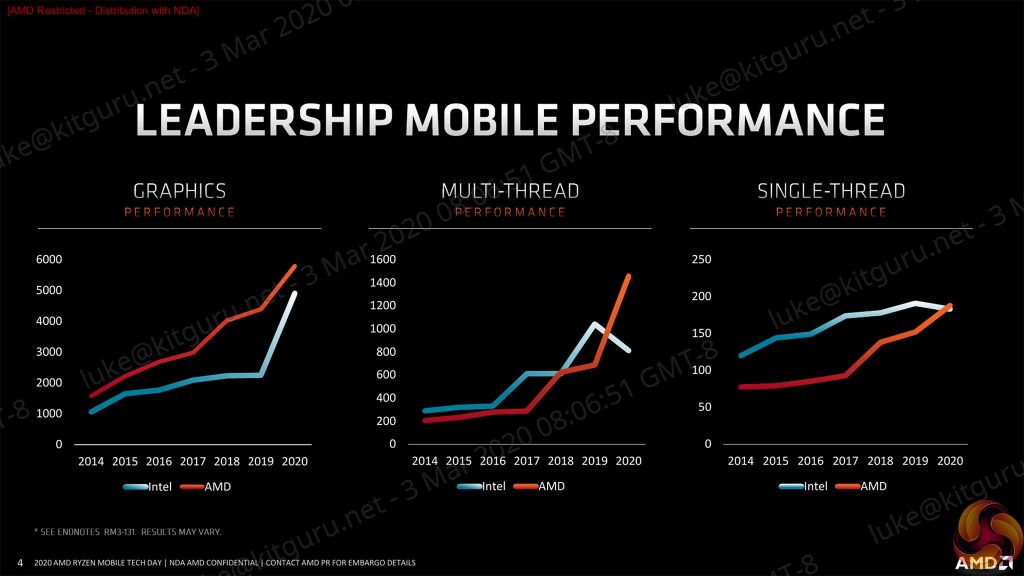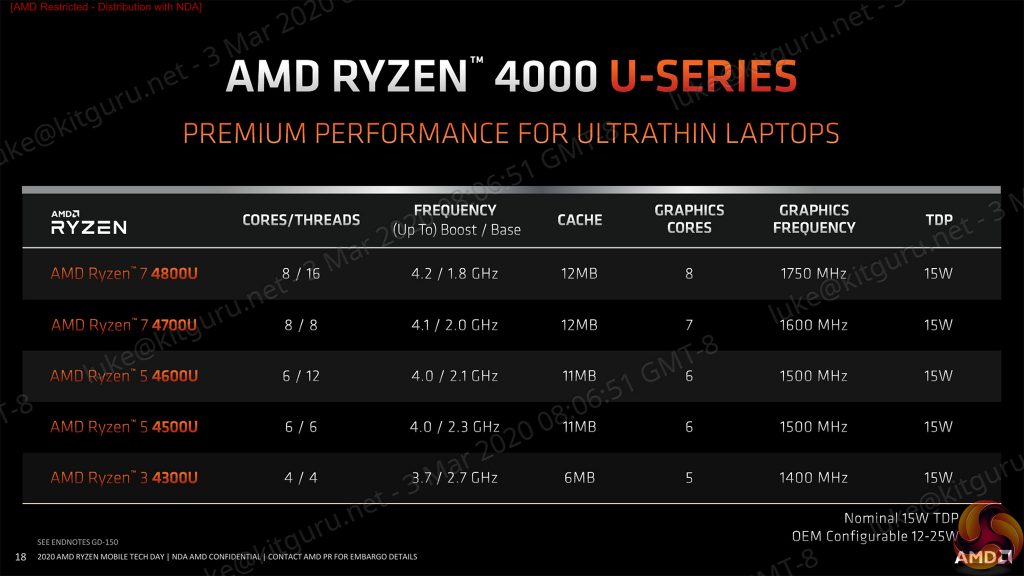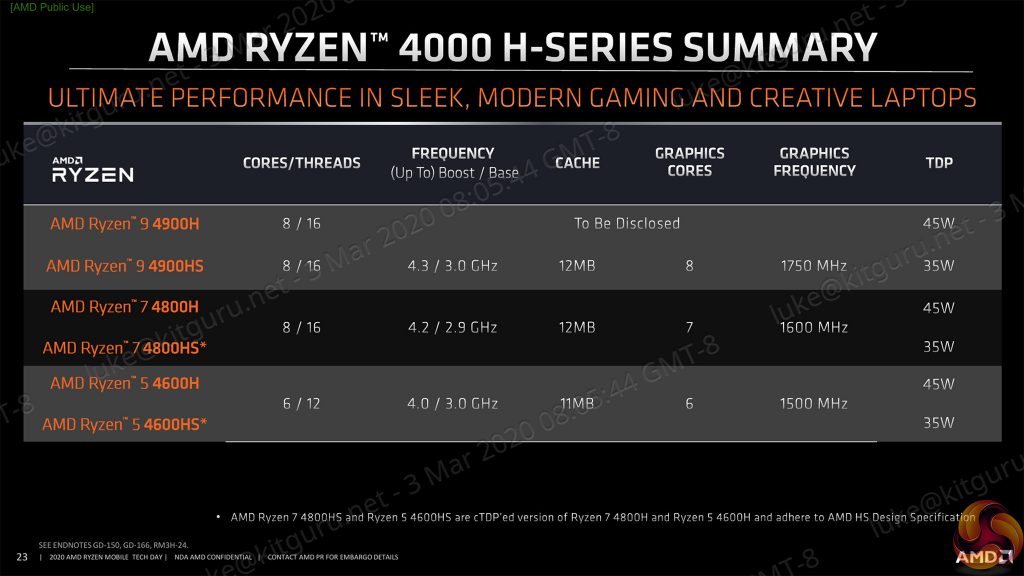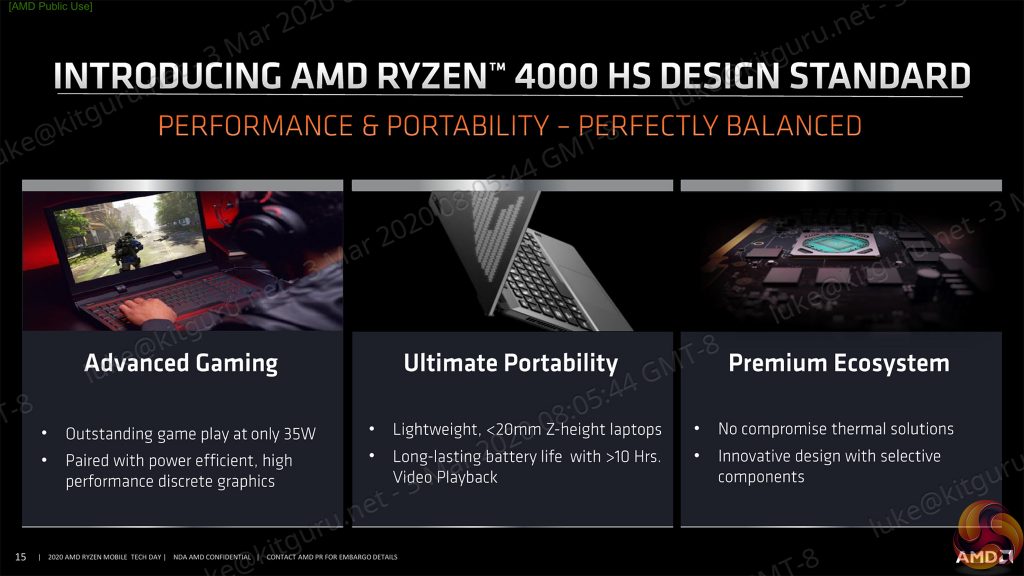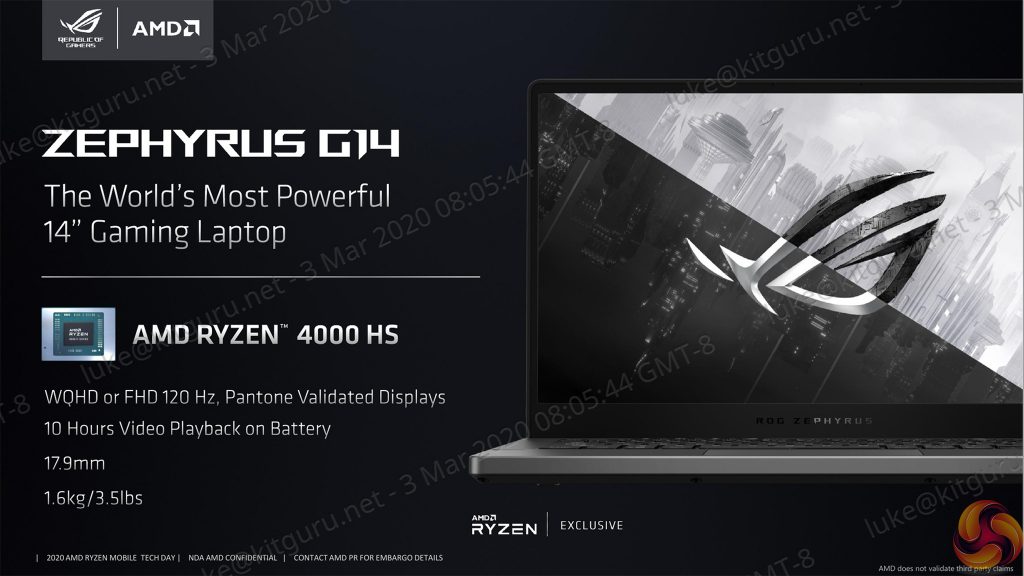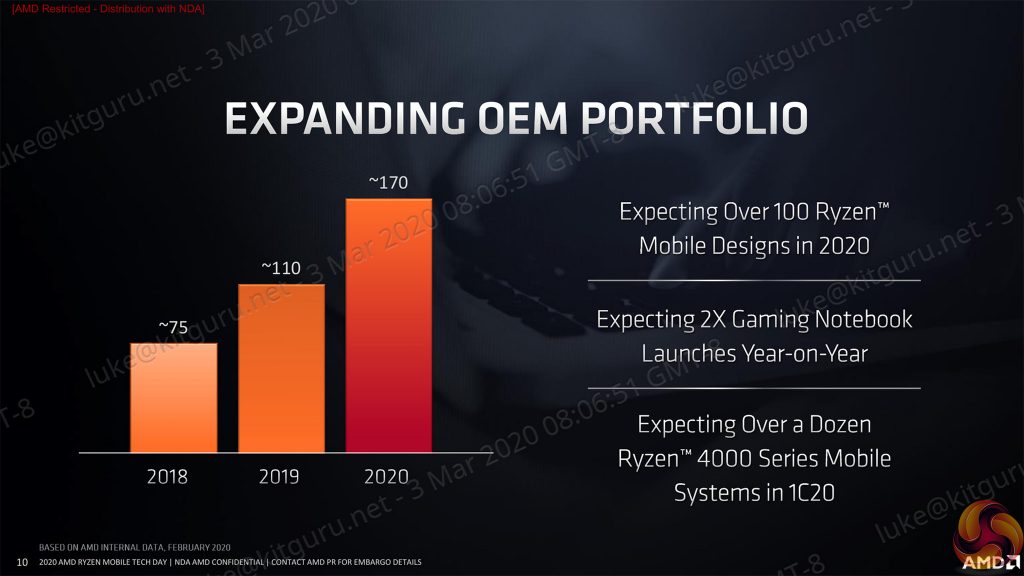First announced at CES 2020, AMD is gearing up for the launch of its Zen 2- and Vega-based Ryzen 4000 ‘Renoir’ APUs for laptops. Targeting the mobile market that Intel has dominated for as long as most people can remember, AMD is bringing higher core counts to the low power segment and is banking on alluring GPU performance versus Intel’s Comet Lake-U, Ice Lake, and Coffee Lake Refresh competition.
The main details for Ryzen 4000 ‘Renoir’ mobile APUs are already well understood at this point, given the announcement at CES 2020. The SoC is built on TSMC’s 7nm process technology, which AMD claims is responsible for around 70% of the performance gains from the Vega GPU and Zen 2 CPU cores (versus previous generation 12nm comparisons).
Eight-core, sixteen-thread offerings will lead the pack for both the 45W-class H-series SKUs and the 15/25W-class U-series SKUs. Eight cores and sixteen threads is a new level that we have not yet seen from ‘ultrabook’ class 15/25W chips as Intel’s Comet Lake-U parts top out at six cores and twelve threads.
LPDDR4X memory support is another factor that signals AMD’s move to more modern ancillary components for use in the Ryzen 4000 Mobile ecosystem.
One clear topic of discussion is the use of the older Vega GPU architecture rather than AMD’s latest RDNA alternative. AMD highlighted how everything is closer together on the die using the 7nm manufacturing node, and this helps the Vega GPU’s clock speed to be increased to enhance performance.
Another factor was that it would have simply been difficult to adapt RDNA into the SoC design in the given timeframe. Work on Ryzen 4000 would have begun over 2 years ago, at which stage RDNA was not released and would have still been work in progress.
Critical to AMD’s strategy is the balance it aims to offer with Renoir. Particularly in the ultra-portable U-series 15/25W market segment, AMD is keen to point at that Intel’s competitors force a user to compromise on their purchasing decision.
If you want cores, clock speed, and compute performance, you should be looking at Comet Lake-U but accepting older, lower performance graphics capability. With Ice Lake, you get the newest CPU architecture, 10nm process technology, and more powerful graphics, but CPU compute performance is compromised due to modest operating frequencies and a maximum core count of four.
According to AMD, its flagship U-series part – the Ryzen 7 4800U – will offer a balance between compute performance and graphics performance thanks to its eight multi-threaded Zen 2 CPU cores with the eight Vega-based graphics cores that are blended together on TSMC’s 7nm node.
That balance, says AMD, will allow for reasonable 1080P gaming performance on U-series processors thanks to the GPU’s capability. Real gaming performance using the iGPU is an area where Intel’s competition has historically struggled.
Of course, battery life is the other spoke in the critical trifecta for U-series processors. During its Renoir Tech Day in February, AMD highlighted how achieving strong battery life is far more complicated than simply using an efficient architecture and process node to drive down power consumption. Processor and operating system power states are critical factors in the equation, as are the decisions on when to move between different power states.
For example, triggering a command to switch to a less energy intensive power state requires the data held in caches to be written and then flushed. This takes energy to do so. As such, the transition to the lower energy state requires energy. If that lower energy state is only going to be required for a short period of time, the net energy usage of switching to it may be higher than the amount of energy it saves over the entirety of the process.
Simply put, it is critical for the system to predict the best power states for the processor to be in early so that the energy used in switching is minimised and the relevant level of performance is provided.
Of course, low-power U-series parts are not for everybody. Many mobile users still command strong levels of compute performance and the ability to be partnered with a dedicated GPU. That’s where AMD’s 45W-class H-series Ryzen 4000 Mobile SKUs fit in.
Leading the pack will be the eight-core, sixteen-thread Ryzen 9 4900H. This processor was not announced back at CES 2020 but AMD confirmed its existence at the Renoir Tech Day and showed off an ASUS laptop housing the part. Realistically, the Ryzen 9 4900H is very similar to the 8C16T Ryzen 7 4800H. The key changes are an increase in the number of graphics cores and their speed, as well as higher base and boost clocks for the CPU cores and higher clock residency, according to AMD.
If eight cores is not necessary for your usage and you’re more concerned with solid compute performance at a reasonable price, I expect the six-core, twelve-thread Ryzen 5 4600H to be particularly competitive. That point will be especially true when we see the APU in systems partnered with a budget-conscious discrete GPU.
One point of note is that ‘S’ suffix after some of the processors. This forms part of AMD’s ‘HS Design Standard’ that it is pushing to OEMs. Several factors go into AMD allowing its OEM partners to use the HS design spec.
Most notably is the reduced TDP to 35W for the Ryzen 4000 APU. This configurable TDP down (cTDP) setting allows the processor to operate at a lower clock speed while maintaining use of all the physical resources. In turn, this should help to reduce the thickness of required cooling hardware and enhance the battery life, which is another factor that AMD forces on its partners – no El Cheapo batteries allowed for HS design standard laptops.
As well as restrictions on the physical dimensions that force vendors to use premium chassis materials and design logics, another critical factor in the HS design standard is a pairing of the APU with a discrete GPU to allow for solid gaming performance.
AMD expects partner vendors to opt for Navi 10 or Max-Q GPUs typically and we have seen an example of ASUS using the Ryzen 9 4900HS with an RTX 2060 Max-Q for its Zephyrus G14.
It is interesting to see AMD enforcing specific rules onto its OEM partners who want to use the ‘S’ suffix processors. The HS design standard reminds me a little of Intel’s Project Athena or Ultrabook push whereby the chip maker works closely with laptop vendors to produce a premium, well-optimised offering to customers.
Clearly, AMD has lofty goals with Renoir and that’s completely understandable given Intel’s dominant position in the mobile processor market. At its Renoir Tech Day back in February, AMD was keen to highlight over 100 Ryzen Mobile systems will be available during 2020 – a statistic that is clearly designed to show that OEMs are taking Ryzen 4000 Mobile seriously.
It will be interesting to see what sort of buy-in AMD gets from large vendors such as Dell, Lenovo, HP, and ASUS. We have already seen details of Lenovo’s upcoming 14” Yoga Slim 7 using the Ryzen 7 4800U and ASUS’ Zephyrus G14 looks incredibly promising with up to a Ryzen 9 4900H calibre processor. Given the current situation of turbulence around the globe, we have a few more weeks to wait before the performance data can be shared and the systems will be on shelf around the world.
Discuss on our Facebook page HERE.
KitGuru Says: AMD is aiming to compete with Intel in the mobile scene to the same extent that the vendor has battled Intel successfully in the desktop and enterprise CPU space. Do you think AMD will be able to match Intel’s well-optimised offerings? And which products from the Ryzen 4000 line-up are you most interested in? Check back next month for our full hands-on analysis and more comprehensive architecture breakdown.
 KitGuru KitGuru.net – Tech News | Hardware News | Hardware Reviews | IOS | Mobile | Gaming | Graphics Cards
KitGuru KitGuru.net – Tech News | Hardware News | Hardware Reviews | IOS | Mobile | Gaming | Graphics Cards


